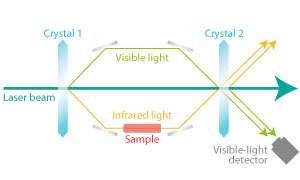A quantum effect allows infrared measurements to be performed by detecting visible light

By weaving some quantum wizardry, A*STAR researchers have achieved something that appears to be a contradiction in terms—using visible light to perform spectroscopy at infrared wavelengths. Even more mysterious is that the visible light does not even pass through the sample being measured.
Infrared spectroscopy is widely used by chemists to identify chemicals from their unique 'fingerprints' in the infrared region. However, infrared-light sources, elements and detectors tend to have inferior performances and be more expensive than their visible light counterparts.
Now, Dmitry Kalashnikov at A*STAR Data Storage Institute and his co-workers have hit on a way to overcome this problem and realize the best of both worlds—using visible light to perform measurements in the infrared region.
They achieved this by exploiting a quantum effect known as entanglement. In this phenomenon, two quantum particles (in this case, particles of light known as photons) are so intimately connected that changing the quantum state of one particle simultaneously alters the state of the other particle, even when the two particles are separated in space. This is the "spooky action at a distance" that Einstein famously objected to.
Kalashnikov and his team used a special crystal to create a pair of entangled photons, a visible one and an infrared one (see image). The infrared photon passed through a sample, whereas the optical one did not. The two photons then crossed at a second crystal and the visible photon was detected. Since any changes that the sample induced in the infrared photon were reflected in the visible photon, the team could infer information about the sample's infrared properties by measuring only the visible photon.
The researchers demonstrated the potential of this technique by using it to measure the presence and concentration of carbon dioxide in samples of air.
"We are confident that this method will find a broad variety of practical applications, for example in environmental monitoring and health diagnostics," says Kalashnikov.
"This study demonstrates that quantum optics is moving out of the realm of purely fundamental science," he adds. "We are seeing a rise of practical applications in different fields, including cryptography, metrology, imaging and sensing. Our work is another example of this trend."
The team intends to extend the technique to longer wavelengths in the terahertz and far-infrared ranges. They are also considering integrating the system on single platform, which would make it easier to implement.
More information: Dmitry A. Kalashnikov et al. Infrared spectroscopy with visible light, Nature Photonics (2016). DOI: 10.1038/nphoton.2015.252
Journal information: Nature Communications , Nature Photonics





















